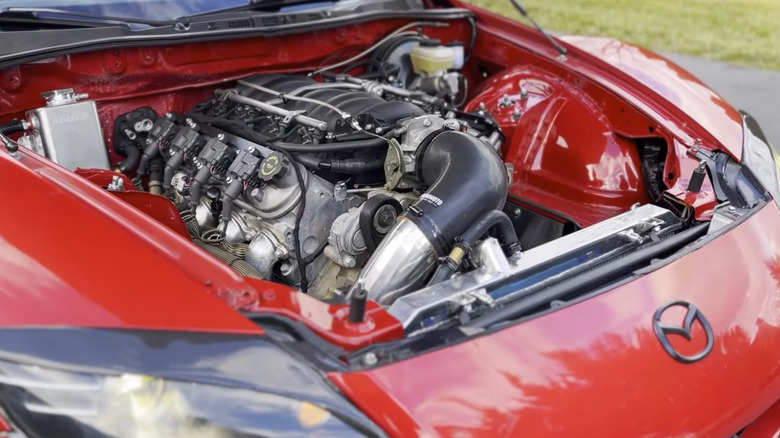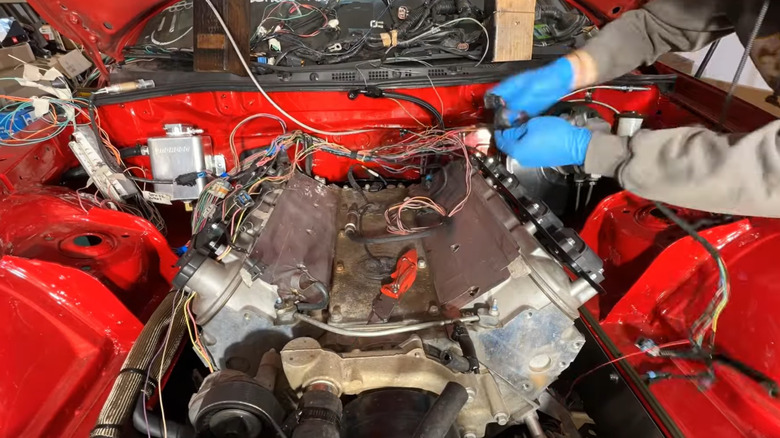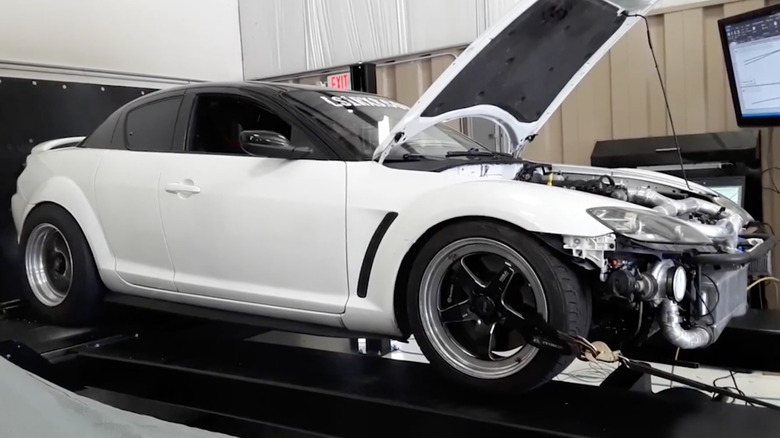Is It Worth LS-Swapping A Mazda RX-8? Here's What Owners Say
LS swaps are nothing new — if anything, the street performance world has been stuffing GM's finest big-cube V8 in just about anything that would take it for years now. Porsches, E36 BMWs, Mustangs, Nissan Silvias, Subaru BRZs, and a more recently, the Mazda RX-8.
In case you didn't know, an LS swap is a popular engine swap trend that replaces the stock powertrain with a General Motors LS V8, as seen in Camaros and the like. It might seem crazy to replace Mazda's high-output 1.3-liter Renesis two-rotor engine with a massive V8, but the benefits outweigh the infamous reliability and maintenance issues.
Let's cut to the chase — yes, LS swapping a Mazda RX-8 is worth it, but there's a catch: It's only an ideal swap for the right owner. According to owners with LS swaps, you need a lot of money, off-the-shelf parts, and, in case you lack the technical know-how to do it on your own, a good shop to do the conversion for you. However, if you are looking for more power and reliability, but on a budget, an LS-swapped Mazda RX-8 might not be the project for you.
Why an LS-swapped Mazda RX-8 is worthwhile
The Mazda RX-8 gets a lot of attention due to its unique 1.3-liter rotary engine. It's particularly popular among gearheads for its high-revving and high output capabilities. However, on the flip side, it is marred by reliability issues. "Probably the most untalked problem with the Renesis is always have a backup car," an RX-8 owner on Reddit confessed about its unreliability. The Renesis rotary engine's apex seals, or the seal between the rotor and housing during combustion, are notorious for failing, leading to low compression issues and, eventually, engine damage. The Renesis requires specialized maintenance and, in some cases, costly repeated rebuilds.
Due to its maintenance issues, car enthusiasts who love the RX-8's great chassis and four-door practicality, but want to improve on its reliability while enjoying significant power and torque gains, opt for an LS swap. "Literally, the only single downside of swapping in an LS is losing the uniqueness of the rotary," another owner explained on Reddit.
It isn't one of the strangest LS engine swaps, and for that reason, there is a huge aftermarket support with dozens of swap kits and guides from different companies, but they are not cheap. According to experiences from previous owners, when done well, these swaps offer significant performance improvements without compromising drivability. It's worth noting that an LS-swapped Mazda RX-8 is more practical when paired with a 6-speed manual transmission with proper cooling aids.
What owners regret
An LS swap may sound easy because it has been done on dozens of platforms. However, on the Mazda RX-8, it's not a cheap project to undertake. Based on owner experiences, the costs are pretty significant. An LS crate motor costs between $3,000 and $7,000, depending on whether you build one or buy a crate engine. The swap kit, which includes engine mounts, headers, and an oil pan, can cost between $2,000 and $5,000. If it's not a DIY project, installation can cost anything between $5,000 and $10,000, depending on the region. Add that to extra mods, and you are looking at a ballpark cost of between $15,000 and $25,000.
With extra torque comes extra stress on the chassis — in case the original chassis wasn't reinforced during the swap, it could lead to potential long-term wear, compromising handling. Let's not forget the part where you lose traction control, cruise control, and stability control.
Still, for performance enthusiasts, the joy of owning a unique car such as an RX-8 with an LS small block, is worth the trouble and cost. Also, the pleasure of owning a Mazda RX-8 that starts every time and rips like a freight train is worth pursuing.


